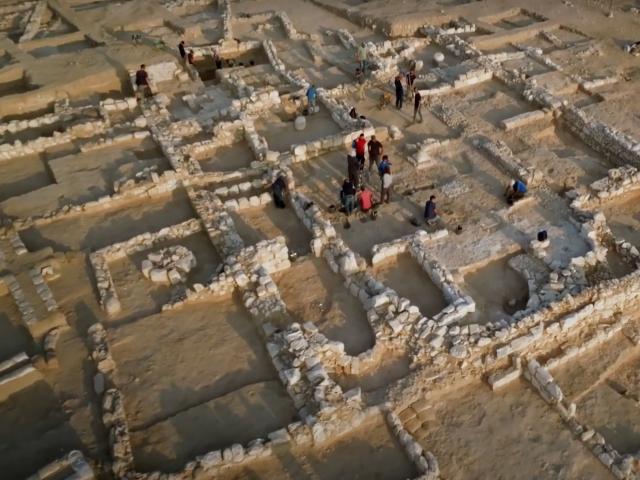In a remarkable archaeological discovery, researchers have unveiled evidence of sea-faring methods used approximately 1,500 years ago to transport Christian pilgrims to the Holy Land. This finding emerged during an excavation of a Byzantine-era church near the Bedouin city of Rahat in the northern Negev desert, far from any current shoreline.
Discovery and Location
The site, located just a half-day's walk from the ancient port of Gaza, lies along an ancient Roman road that connected the coast to Beer Sheba. This strategic position suggests that the church served as an early stop for pilgrims beginning their sacred journeys to Christian sites such as Jerusalem, Bethlehem, and various monasteries in the Negev Hills and Sinai.
Excavated Negev Church Walls Reveal Images of Ancient Ships - @JewishPress - https://t.co/dOMdBWnglp pic.twitter.com/SmI1OztbDI
— JewishPress.com (@JewishPress) May 23, 2024
Evidence of Sea Travel
Archaeologists identified intriguing wall art within the church, depicting ships. These illustrations provide concrete evidence of the maritime journeys undertaken by pilgrims. The excavation, led by Oren Shmueli, Dr. Elena Kogan-Zehavi, and Dr. Noé David Michael from the Israel Antiquities Authority, alongside Professor Deborah Cvikel from the University of Haifa's Department of Maritime Civilizations, sheds light on the historical significance of these sea passages.
Detailed Depictions
The ship drawings offer fascinating insights into the maritime practices of the time. Professor Cvikel described one detailed depiction: "It may be discerned that its bow is slightly pointed, and that there are oars on both sides of the vessel. This may be an aerial depiction of the ship, though it seems the artist was attempting a three-dimensional drawing. It may be that the lines below it portray the path beaten by the oars through the water."
Church Walls Revealed by Excavations Portray 1500-year-old Ships in Northern Negev, Gaza [VIDEO]
— Storie&Archeostorie (@StorieArcheo) May 23, 2024
@antiquities_ilhttps://t.co/be9RFnsKNL
Another illustration features a two-masted ship, with the main mast devoid of a sail but adorned with a small flag. The fore mast, slightly raked towards the bow, bears a sail known as an artemon. The precise nature of these drawings indicates the artist's familiarity with maritime life, highlighting the integral role of sea travel in the pilgrimage process.
Archaeological Significance
The presence of these ship drawings is similar to ancient graffiti left by Christian pilgrims at Jerusalem’s Church of the Holy Sepulchre. This connection underscores the widespread practice of pilgrims leaving their marks as they journeyed through sacred sites.
Archaeologist Daria Eladjem noted the unique orientation of one drawing: "Since the drawing was found upside-down, it seems the person placing the stone during construction was either unaware it bore a drawing, or did not care."
Broader Context
The excavated site narrates the story of settlement in the Northern Negev during the transition from the Byzantine to the Early Islamic period. The ship drawings not only offer insights into the maritime world of the time but also into the personal experiences of the pilgrims who traveled these routes.
1,500-year-old Byzantine-era ship etchings revealed at Negev church https://t.co/s0Ki0qkEvK
— The Times of Israel (@TimesofIsrael) May 23, 2024
Eli Escusido, Director of the Israel Antiquities Authority, emphasized the importance of this find: “This surprising and intriguing find of ship drawings in a Northern Negev Byzantine-period church opens a window for us to the world of Christian pilgrims visiting the Holy Land 1,500 years ago, and provides first-hand evidence about the ships they traveled in and the maritime world of that time."
Presentation to the Public
The discovery was made during an expansion project to add a new neighborhood in Rahat, funded by the Authority for Development and Settlement of the Bedouin in the Negev. The Israel Antiquities Authority, which has been conducting excavations in the area for several years, will present this discovery to the public for the first time at the Rahat Conference on June 6. The conference will also showcase many other findings from excavations in the city and surrounding area.Conclusion
This extraordinary find not only enriches our understanding of the historical journeys undertaken by Christian pilgrims but also offers a unique glimpse into the maritime practices of the Byzantine period. The detailed ship drawings in the northern Negev church stand as a testament to the enduring significance of sea travel in the ancient pilgrimage to the Holy Land.


